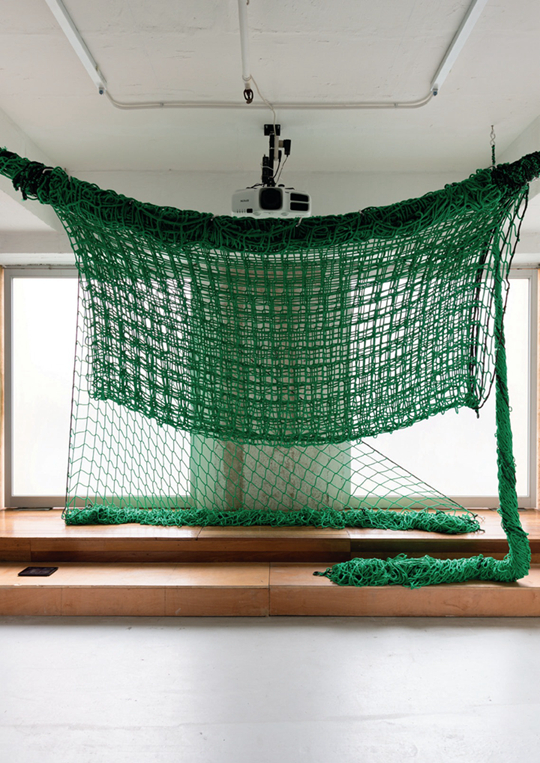SOUTH BY SOUTHEAST
| July 9, 2015 | Post In 2015年6月号

2013, sculpture and spatial intervention, dimensions variable
Courtesy the artists and Osage Art Foundation
PHOTO: Kwan Sheung Chi
With “South by Southeast,” Filipino curator Patrick Flores and Romanian curator Anca Mihuleţ propose the new interpretive dimension of “southeasternness” by looking at generalized geographic concepts of southeast Asia and southeastern Europe. With this as a starting point, the curators launch a distinctive experiment in juxtaposition, attempting to transcend both geopolitics and a bipolar narrative of east and west.
Twenty-nine artists from 17 countries and territories graft an astonishing amount of information onto the theme. To a certain extent, the exhibition title reverses stereotypes concerning these southeastern regions. Apart from tourism, how can Thailand, Myanmar, Cambodia, and Sri Lanka conceive of their identities within contemporary culture? Since the upheavals in eastern Europe, what is the relationship between art and social transformation in Slovenia, Bulgaria, Bosnia and Herzegovina, and Serbia? How do capitalism, socialism, globalization, and postcolonialism intersect and permeate the southeast? Just as it is impossible to clearly define the post-Cold War era in a satisfying way, the concept of southeasternness proposed against this larger backdrop cannot be summarized by specific characteristics. The value of the exhibition lies in the expression of a certain cultural overlap, a relationship of correlation unfolding in parallel.
Osage Gallery’s bright, open exhibition space is divided into three long, equal zones. Installation and video work takes up a sizeable majority of the space. Many pieces unmistakably refer to social and political issues; their sense of satire and radical tone is equally unambiguous. In Taiwanese artist Yao Jui-chung’s video Long Live, the camera moves from wide shots to close-ups within the gloomy, tense spaces of bomb shelters, air raid sirens, and war, while a man wearing a military uniform in a ruined hall mechanically and repeatedly salutes while shouting, “Long live!”—the spirit of authoritarian governance made flesh. Filipino artist Pio Abad’s artwork Phantasy Bird Carrying Village finds its origins in the exhaustive transcript of a government report hinting at political turmoil in the communist Philippines during the late Cold War.
Extended slightly further, these political and social questions lead naturally into interrogations of how history is written, which is how the border-crossing interactive internet project From Bandung to Berlin is realized. This website, created by a group of artists and researchers from Indonesia, Malaysia, China, the Philippines, and other former Third World countries, is anchored in two landmark historical events: the 1955 Bandung Conference (where the concept of the Third World originated) and the 1989 fall of the Berlin Wall (symbolizing the end of the Cold War and the triumph of capitalism). It aims to “create a new chapter of history” through an immaterial platform, with questions printed on note cards: “What if the Berlin Wall hadn’t fallen in 1989? Or what if Maphilindo had become a hegemon in East Asia? Would the world we live in be different?” Similarly, the two-channel video piece Storical Affairs by Hong Kong artist Leung Chi Wo features an official Chinese history textbook in Japanese, alluding to the specious ways history can be written in different contexts.
Elsewhere, site-specific work makes for the highlight of the exhibition, resonating with contemporary Hong Kong society to varying degrees. Among others, Romanian artist Dan Perjovschi paints succinct and witty images on glass walls at the end of the exhibition space, incorporating several hotbutton issues in Hong Kong society: overworked white collar laborers, income inequality, and the Umbrella Movement.
Text by Wu Mo
Translated by Patrick Rhine

